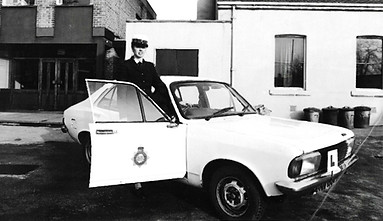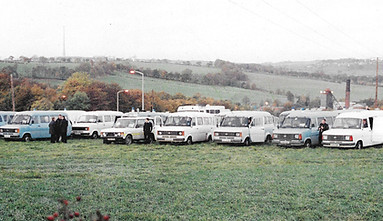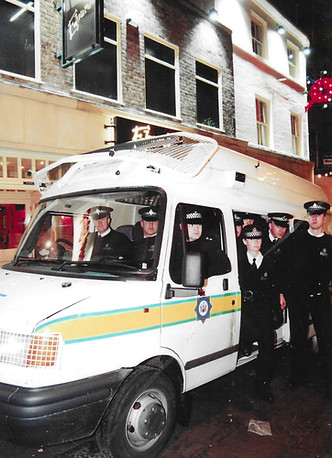Centenary Square, Bradford, BD1 1HY
Open every Saturday, from 10:00 - 15:00




Patrolling the Past:
Police Transport
Through The Decades
Patrolling the Past: Police Transport Through The Decades is an online journey through over a century of police transport in Bradford. This exhibition explores how the city's police force adapted to the changing demands of urban life - from patrolling the streets on foot and horseback to using motorised vehicles equipped with the latest technology.
Step through time to see how transport shaped the way the police served the public. Discover the early days of mounted patrols, the cautious adoption of motor cars, and the groundbreaking use of radio communication in the 1930s. Learn how post-war austerity challenged innovation - and how the blue and white patrol cars of the 1970s came to symbolise a new era of policing.
Through photographs, historical documents, and eye witness accounts, this exhibition tells the story of how mobility, technology, and public service came together to transform policing in Bradford and the wider West Yorkshire region.
Before Modern Vehicles
For much of the 19th century the Bradford Borough and City Police Forces patrolled Bradford on foot. From the 1870s, the appearance of constables on horseback became more common.
Between 1892 and 1900, the Bradford Borough and City Police began to build up a permanent mounted police force. In 1896 the Bradford Borough Police had twelve constables assigned to the mounted section.
By 1900, horses pulled the police ambulance, prison van and fire engines in Bradford. Extra horses, however, were hired in special circumstances to be ridden by Bradford City Police Constables.
The heyday of the mounted section proved to be short lived. Throughout the latter half of the twentieth century, the Bradford City Police on horseback was usually only seen in parades, competitions and in crowd situations (riots, strikes, and public events).


© The Bradford Police Museum
© The Bradford Police Museum
The Beginning of Modern Police Vehicles
Between 1903 and 1914 there was a rapid increase of motor vehicles on Bradford's street - however, the Bradford City Police were slow to emulate the example set by the public.
Until 1915, the Bradford City Police owned only one motor car and a single 1915 Jowett motorised ambulance which cost £468. Even in 1923, the police force only had four motorised vehicles, in comparison to the over 6,600 vehicles used by the public. In 1930, the number of police drivers had only increased to six men.
As technology progressed, the force’s horse drawn prison vans and police ambulances were replaced between 1925 and 1930 for two motor ambulances and two motor prison vans.


Bradford Police motorcycles in Peel Park during the 1920s and 1930s.
Police Ambulance in Aldermanbury, 1934
© The Bradford Police Museum
© The Bradford Police Museum

© The Bradford Police Museum
Road Traffic Act, 1930

© The Bradford Police Museum
An extract from the 1930's Highway Code detailing handsignals
A New Chapter
The appointment of Thomas Rawson as Bradford’s Chief Constable in 1931 heralded a new chapter in Bradford City Police Transport.
Throughout the 1930s Chief Constable Rawson advocated for an increase in mobility for the Bradford City Police equipped with radio communication.
In July 1934, Bradford City Police made history when it became the first force to transmit a radio message from the City Hall police station to PC Eric Thistlewaite on his police motorcycle. The first mobile traffic branch in Bradford was started in 1937.
In 1936 a ‘magnificent’ new 25 H.P. Morris was purchased to use on official occasions and eight new useful Morris 8 tourers were also acquired. These Morris vehicles would have been equipped with a radio to help them pursue suspects during patrol.

Morris Eight Tourer Police Cars outside the Central Fire Station, Nelson Street, 1936
© The Bradford Police Museum

© The Bradford Police Museum
A Bradford PC's first week doing Traffic Duty in the 1950s
"A wonderful tour of duty 9 am to 5 pm, this was great. I was shown traffic duty, which I had never done. Along with another officer I went to a traffic point duly dressed in my white gloves and white cuffs. He went on to the trafic point first and I had to observe what he did. I then moved into the centre of the road and stood behind him. This point was the centre one of three so I had to work along with the other two point duty men. It caused problems if this was not done properly. Being the kind officer that he was he waited till he thought that the heaviest of the traffic had gone, then he put me in position. I thought that I was conspicuous when I put on my uniform but here I felt that every passing pedestrian and driver was examining what I did with a critical eye....[after a week] I had never known pains in the back to be so severe. If I didn't stand up straight and give good clear signals, the drivers would not see me. Or so they would say if anything went wrong and I was almost under the wheels of the vehicle they were driving"
- W H Copper
A Bradford PC's account of life in Traffic Branch in the 1950s
"I had a lot to learn. Not forgetting that we were still operating a police vehicle on a patrol and dealing with messages that were transmitted to us. All messages transmitted to our car had to be written in a log book in long hand. Any messages that were passed to all cars also had to be written with the time sent, time completed and the position of the car....Working from traffic branch and attending more incidents certainly gave me more experience of the work of a police officer. A man on the beat in a district out of the city would never come across some of the reports that were dealt with in this division"
- W H Copper

© The Bradford Police Museum
Vespa Motor Scooter at Bolling Road Police Garage in Bradford in the 1950's

© The Bradford Police Museum

The Sunbeam Tiger was used by the Leeds City Police in the 1960s.

© The Bradford Police Museum
© The Bradford Police Museum
A Bradford PC's pride at joining the Traffic Division in the 1950s
"Back to the police station "you will be going up to the traffic division on Monday, parade there at 8 am". This rang in my ears for the rest of the day, it could not come soon enough for me. My day leave fell on a Sunday so that helped. Go to stores and collect a flat cap and a pair of driving gloves. This was the true insignia of the members of the traffic division but apart from that I was going to be taught how to drive correctly"
- W H Copper
Jaguar Police Cars in the 1960s.
Bradford's Post-War Traffic Evolution
The outbreak of the Second World War and the subsequent austerity of post-war Bradford meant a lack of money, petrol and manpower for Bradford City Police to update their vehicles during the 1940s.
The end of the war led to one of the most notable developments. In 1946, the Bradford City Police began to use radio-equipped patrol cars on a regular basis.
The 1950s and 1960s saw a new purpose built ‘Traffic Headquarters’ erected on Bolling Road.
In the 1960s and 1970s the use of motorcycles like the Douglas Vespa Scooters and Triumph Tigress 250cc Scooters became widespread.
Ford Zephyr 4 in Forster Square , Bradford in early 1960s

Ford Zephyr 4 Patrol Car Early 1960's (note additional side lights fitted for safety)

© The Bradford Police Museum
© The Bradford Police Museum
A Bradford PC's account of traffic duty in the 1960s
"In the 60's, trained traffic officers drove Ford Zephyr 4's and 6's. In A Division, authorised drivers were allowed to drive the Divisional Van and Prison Van. I had not passed my driving test when I joined. I later went on a two-week intensive course from Bolling Road Traffic Division with a Sergeant which then enabled me to drive vans and CID Ford Escorts. My first duties in A Division included traffic control, 'point duty' at the bottom of Manchester Road, and also Forster Square. I patrolled various streets in the City Centre - one street for eight hours looking out for parking offences (there were no traffic wardens) and monitoring offences (one had to justify one's existence but the number of persons reported in one's notebook on a monthly basis). The worst part of the job, apart from the shifts and working weekends, was having to deal with deaths and people injured through violence or road accident injuries"
- G Shores
A Bradford PC who joined in the 1960's on the admiration for his colleagues from Traffic
"I joined in 1965 and I was assigned to PC Les Baxter on B4 Patrol Traffic (later incident) Car - recruits would spend the first three months on one of four cars to familiarise themselves with the Force area. My time with PC Baxter and others in the police was extremely educational - through I was never formally posted to Traffic, I served in some way or another in every department of the police and I never lost my admiration for the men and women who were Traffic Officers"
- J B Robinson
Blue & White is the New Black
During the 1970s some of the most iconic British and American cars and vans ever produced began to be used on patrol in Bradford, including Austins, Zephyrs, Escorts, Triumphs, Land Rovers, and Consul - all in blue and white instead of the black used prior to the 1960s in Bradford’s police vehicles.
The best example of this colour change is Bradford’s last standard traffic patrol car, the gleaming all white Triumph 2000.


Hillman Avenger beat vehicle in the 1970's
Hillman Avenger Driving School Vehicle at West Yorkshire Police Driving School in the 1970's
© The Bradford Police Museum
© The Bradford Police Museum

© The Bradford Police Museum
A Parking Ticket Pre-1974

© The Bradford Police Museum
A page from a 1973 Road Traffic Guide used as an aide
A West Yorkshire PC's account of learning to drive in the 1970's
"I only drove cars throughout my service. To qualify, one had to pass a practical driving exam. There was then a short three-week standard driving course for officers with a license to perfect their skills. Otherwise there was a five week course for complete novices. By far the best organised and effective course was my short standard course. We shared the driving duties and the techniques they taught us were first class - I still use the techniques I was taught in 1979. The best car I ever drove in the police was the Vauxhall Astra"
- S Taylor

© The Bradford Police Museum
Rover 3.5 SDI, circ 1980's
A West Yorkshire PC fondly remembers the cars he drove in the 1980s
"I was lucky, in the 1980's - at the age of 19 - I was put forward for a driving assessment and ended up patrolling Eccleshill, Ravenscliffe and Fagley. I loved it. Living in the area meant I could call home for a cuppa. I drove Ford Escorts, Hillman Avengers, Morris Itals and Mini Metros. Hardy state of the art but still better than most of my friends. In 1984, I graduated to a Rover 3.5 SDI when I transferred to TF and creed an IRC. Then the ultimate car, a Sierra 2.8 4x4. Things went downhill from there!"
- N Booth

© The Bradford Police Museum
Rover 3.5 SDI, circ 1980's
The 1973 Range Rover on Duty
The last significant purchase of this decade made by the Bradford City Police was undoubtedly the Range Rover bought in 1973. It was equipped with the latest safety and rescue equipment and sported an extending ten-foot roof beacon and floodlight.
Bradford City Police Range Rover, 1970's

Police vans preparing to create a barrier in West Yorkshire during the Miner’s Strike.

© The Bradford Police Museum
Amid the Miner’s Strike in the 1980s, these police vans were used to create barricades to maintain law and order and to prevent picketers from interfering with movement of vehicles from the mines, especially those carrying coal.
© The Bradford Police Museum
A West Yorkshire PC describes diving the Bradford Central Division Van in the late 1970's
"We patrolled the City Centre each night between 6pm and 2am. The Ford Transit Van was used to pick up prisoners, deal with public order and attend incidents. Two constables and a sergeant would crew the van. It was big and cumbersome to drive that van. However you were always pleased to see it when it arrived!"
- M R Baines

© The Bradford Police Museum
Leeds Task Force in Police Prison Van

An extract from a booklet issued by the West Yorkshire Police Driving School regarding the Road Traffic Act 1991
© The Bradford Police Museum


This exhibition was made possible thanks to the dedication of our volunteer curatorial team.
Originally developed as a travelling exhibition, this marks The Bradford Police Museum’s first online exhibition. It will run from Friday 29th August to Friday 31st October.
We appreciate your interest in our museum and look forward to welcoming you in person soon!
To explore more about Transportation in the Police, you can pre-book your tickets for our permanent exhibition space here.